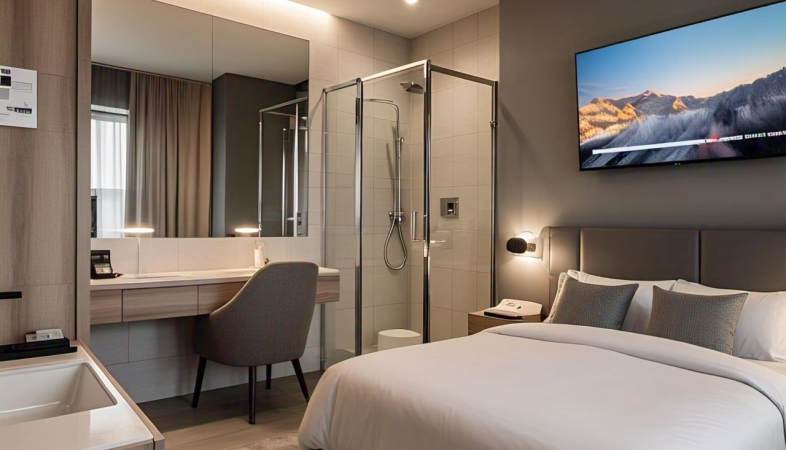Sustainability Meets Luxury: Eco-Friendly Innovations in Hotel Room Design
By using energy-efficient systems, water-saving technologies, and sustainable materials, hotels can reduce operating costs over time.
In recent years, the hospitality industry has undergone a
transformation, with sustainability becoming a key focus in the way hotels are
designed and operated. Today, eco-friendly innovations are not just for
budget-conscious travelers—they are being integrated into luxurious hotel
rooms, offering a perfect balance between environmental consciousness and
high-end comfort. As guests become more environmentally aware, they increasingly
seek accommodations that align with their values while still providing the
top-tier experience they expect. The result is a growing trend of sustainable
luxury in hotel room design, where green practices and luxury features coalesce
to create an extraordinary, yet eco-conscious, stay.
One of the most impactful eco-friendly innovations in hotel room design is the use of sustainable materials. From reclaimed wood to low-impact finishes, hotels are opting for materials that are not only durable and aesthetically pleasing but also sourced in an environmentally responsible manner. For example, bamboo, cork, and recycled metals are becoming common choices for flooring, furniture, and décor. These materials not only reduce the hotel’s carbon footprint but also contribute to a unique and organic feel in the room. The use of natural materials gives the room a timeless quality that blends luxury with sustainability.
Another significant shift in hotel room design is the emphasis on energy-efficient systems. Advanced technology has enabled hotels to create rooms that minimize energy consumption without sacrificing comfort. Smart thermostats, LED lighting, and motion-sensing systems that automatically turn off lights when a guest leaves the room are now standard features in many eco-friendly hotel rooms. These systems help reduce energy usage while still maintaining the ideal lighting and temperature levels for guests. In addition, many hotels are now incorporating solar panels and energy-efficient windows to ensure that their buildings make the best use of renewable energy sources.
Water conservation is also a key aspect of sustainable hotel room design. Hotels are increasingly adopting low-flow fixtures, such as showerheads, faucets, and toilets, which reduce water waste without compromising on the guest experience. Luxury hotels are even incorporating rainwater harvesting systems and greywater recycling, which help conserve valuable water resources. Additionally, towel and linen reuse programs, in which guests are encouraged to use towels for multiple days, have become commonplace, helping to minimize laundry water usage and detergent waste.
The incorporation of green spaces within hotel rooms is another innovative trend that combines sustainability and luxury. Indoor plants are not only visually appealing but also improve air quality and contribute to a sense of well-being. Some hotels are going even further, incorporating living walls or vertical gardens into the design of their rooms. These spaces provide guests with a relaxing, nature-inspired atmosphere while also helping to reduce the hotel’s environmental impact by improving air quality and promoting biodiversity. These green additions make the room feel more connected to nature, offering a serene and eco-friendly retreat for guests.
Sustainable design is also extending to the amenities provided in hotel rooms. Many luxury hotels are now offering eco-friendly products, such as organic toiletries, biodegradable cleaning supplies, and reusable water bottles. These initiatives not only reduce plastic waste but also appeal to guests who want to minimize their environmental footprint during their stay. In-room dining services are also evolving, with hotels offering locally sourced, organic menus and packaging made from sustainable materials. Guests can indulge in gourmet meals without the guilt of contributing to waste or carbon emissions.
Incorporating sustainability into hotel room design is not just about reducing energy and resource consumption—it’s also about creating a lasting experience that aligns with the values of today’s conscious traveler. Guests are increasingly seeking more than just a comfortable place to sleep; they are looking for a holistic experience that takes their environmental impact into consideration. By creating eco-friendly, luxury rooms, hotels can offer this type of experience while remaining competitive in a crowded market. The combination of high-end amenities, cutting-edge technology, and a commitment to sustainability makes for a truly memorable stay, where guests can feel both pampered and responsible.
In addition to attracting environmentally conscious guests, sustainability-focused hotel room designs also provide long-term cost savings. By using energy-efficient systems, water-saving technologies, and sustainable materials, hotels can reduce operating costs over time. For example, lower energy consumption leads to lower utility bills, and durable materials can reduce the need for frequent renovations. These savings, coupled with the growing demand for sustainable accommodations, make eco-friendly hotel room design a smart business decision.
As sustainability continues to play an increasingly prominent role in the hospitality industry, luxury hotels are leading the way in showing that eco-friendly innovations don’t have to come at the expense of luxury. By integrating sustainable materials, energy-efficient systems, water conservation practices, and green spaces into their room designs, hotels are proving that it’s possible to offer an indulgent experience while caring for the planet. As guests continue to prioritize sustainability in their travel decisions, the rise of eco-friendly luxury will only continue to grow, transforming the way we think about hotel design and luxury experiences.
.png)




























